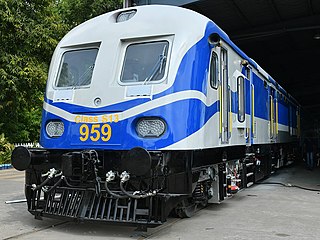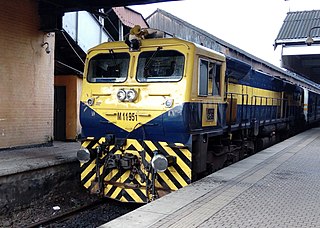
A diesel multiple unit or DMU is a multiple-unit train powered by on-board diesel engines. A DMU requires no separate locomotive, as the engines are incorporated into one or more of the carriages. Diesel-powered single-unit railcars are also generally classed as DMUs. Diesel-powered units may be further classified by their transmission type: diesel–mechanical DMMU, diesel–hydraulic DHMU, or diesel–electric DEMU.

A railbus is a lightweight passenger railcar with an automotive engine. It shares many aspects of its construction with a bus, typically having a bus body and four wheels on a fixed base instead of on bogies. Originally designed and developed during the 1930s, railbuses have evolved into larger dimensions with characteristics similar in appearance to a light railcar, with the terms railcar and railbus often used interchangeably. Railbuses designed for use specifically on little-used railway lines were commonly employed in countries such as Germany, Italy, France, the United Kingdom, and Sweden.

The Sri Lanka Railway Department is Sri Lanka's railway owner and primary operator. As part of the Sri Lankan government, it is overseen by the Ministry of Transport. Founded in 1858 as the Ceylon Government Railway, it operates the nation's railways and links Colombo with other population centres and tourist destinations.

The Kelani Valley railway line in Sri Lanka, covering the breadth of Colombo District. The line is owned, maintained, and operated by Sri Lanka Railways.

The Slow and fast passenger trains are passenger train services of Indian Railways which connect small towns and cities to metropolitan cities in India. The classification Passenger means it is an ordinary passenger train which halts at all or most of the stations on the railway routes. Currently, a total of 3572 passenger trains are running of all railway zones of Indian Railways.

Locomotives and train sets of Sri Lanka Railways consist mostly of diesel locomotives and multiple units. Steam locomotives are no longer used, except on heritage trains such as the Viceroy Special.
"Podi Manike" is a Sri Lankan passenger train running from Colombo Fort to Badulla. This journey covers about 300 km and is renowned for being the most beautiful train journey in Sri Lanka, especially the stretch from Nanuoya to Ella. It takes about 10 hours to complete the journey.

Sri Lanka Railways S11 is a class of Diesel-electric multiple unit (DEMU) train set built for Sri Lanka Railways by Integral Coach Factory, India and imported through RITES Ltd, an Indian state infrastructure corporation on a line of credit extended by the Indian Government. They were built to replace locomotive-hauled passenger trains. Twenty S11 DEMUs were ordered to strengthen long-distance travel on the Coastal Line from Colombo to Matara.

The Main Line is a major railway line in the rail network of Sri Lanka and considered by many to be one of the most scenic train journeys in all of Asia. The line begins at Colombo Fort and winds through the Sri Lankan hill country to reach Badulla.

Sri Lanka Railways Class M8 is a class of Sri Lankan diesel-electric locomotive that was developed by Banaras Locomotive Works at Varanasi, India, in 1996. This class of locomotives was fitted with 2,800 hp (2,100 kW) V16 power units. This is used on both passenger and freight trains on Sri Lanka Railways.

Sri Lanka Railways S12 is a class of Diesel-electric multiple unit (DEMU) built for Sri Lanka Railways by China's CSR Corporation. The first batch arrived in Sri Lanka in August 2012. They were built to replace locomotive-hauled passenger trains. Seven of the S12 DMUs were ordered to strengthen long-distance travel on the Main line from Colombo to Badulla. Four of S12s were built to serve the Kelani Valley Line. The remaining set was designed as a luxury train.
Sri Lanka Railways M3 was a class of Diesel-electric locomotive that was created in 1955 by the Ceylon Government Railway to be used on the Ceylon national rail network.

Sri Lanka Railways S10 is a class of Diesel-electric multiple unit (DEMU) train set built for Sri Lanka Railways by China South Locomotive & Rolling Stock Corporation and imported in 2008. Fifteen S10 DEMUs were ordered to strengthen commuter services on crucial commuter lines.

Sri Lanka Railways S5 is a class of Diesel multiple unit (DMU) train set built by Hitachi and introduced to Sri Lanka between 1969 and 1970, only two of which were imported. The class was built with modern interior facilities aimed towards the special train tours market and is operated by Sri Lanka Railways.
Ceylon Government RailwayS1 was a class of Diesel multiple unit train sets built by English Electric for the Ceylon Government Railway.

Class 201, Class 202 and Class 203 were the TOPS codes for a series of diesel-electric multiple units built for the Southern Region of British Railways in 1957–86. They were classified by the Southern Region as 6S, 6L and 6B respectively, and known collectively as the Hastings Diesels or Hastings Units. They were built for service on the Hastings Line, which had a restricted loading gauge due to deficiencies in the construction of the tunnels when the line was built between 1845 and 1852. The Hastings Units served from 1957 to 1988, being withdrawn when the Hastings Line was electrified with single-track sections through some of the tunnels.

An electro-diesel multiple unit (EDMU) or bi-mode multiple unit (BMU) is a form of a multiple unit train that can be powered either by electric power picked up from the overhead lines or third rail or by using an onboard diesel engine, driving an electric generator, which produces alternating current (AC) or direct current (DC) electric power.

Sri Lanka Railways S13 is a class of Diesel-Electric Multiple Unit (DEMU) train set built for Sri Lanka Railways by the Integral Coach Factory, Chennai and imported through RITES, an Indian Railways PSU on a line of credit extended by the Indian Government in 2011.

Class M11 is a mainline diesel-electric locomotive built by Banaras Locomotive Works, India, for use on Sri Lanka Railways and first delivered in 2018. This locomotive, clearly with its look, was developed from the WDG-4D locomotive of the Indian Railways, which is originally of 4500 hp, as it uses a 16-cylinder variant of the EMD 710 prime mover. The HP was derated to 3000 hp using a 12-cylinder variant of the same engine, making it look and sound similar to British/European Railways' popular Class 66 locomotive, but with AC-AC traction.

Sri Lanka Railways S14 is a class of diesel-electric multiple unit (DEMU) train sets, built for Sri Lanka Railways by CRRC Qingdao Sifang, China and financed by a Chinese sovereign loan. Nine of these train sets were imported to Sri Lanka from 2019 to 2020. They possess air-conditioned first class along with second class and third class accommodations. The Class S14s were ordered to mainly operate on the Main Line from Colombo to Badulla and Kandy.




















